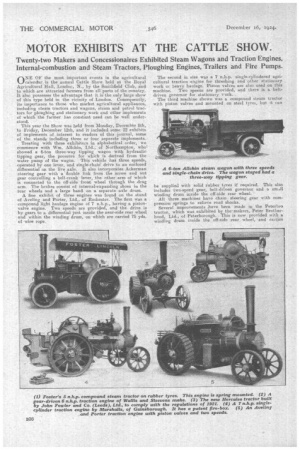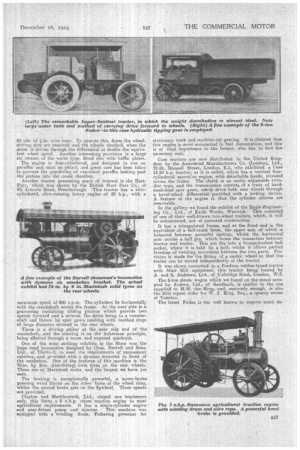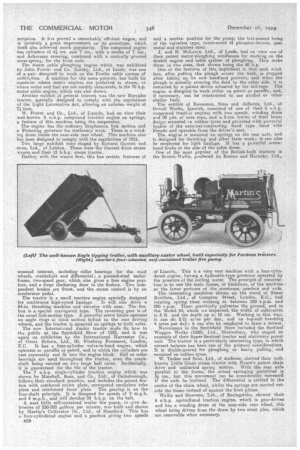MOTOR EXHIBITS AT THE CATTLE SHOW.
Page 20

Page 21

Page 22

If you've noticed an error in this article please click here to report it so we can fix it.
Twenty-two Makers and Concessionaires Exhibited Steam Wagons and Traction Engines, Internal-combustion and Steam Tractors, Ploughing Engines, Trailers and Fire Pumps.
ONE OF the most important events in the agricultural I./calendar is the annual Cattle Show held at the Royal Agricultural Hall, London, N., by the Smithfield Club, and to which are attracted farmers from all parts of the country. It also possesses the advantage that it is the only large show of this type held in the vicinity of London. Consequently, its importance to those who market agricultural appliances, including steam tractors and wagons, steam and petrol tractors for ploughing and stationary work and other implements of which the farmer has constant need can be well understood.
This year the Show was held from Monday, December 8th, to Friday, December 12th, and it included some 22 exhibits of implements of interest to readers of this journal, some of the stands including three or four separate implements.
Treating with these exhibitors in alphabetical order, we commence with Wm. .Allchin, Ltd., of Northampton, who showed a 6-ton three-way tipping wagon with hydraulic tipping gear, the pressure for which is derived from the water pump of the wagon. This vehicle has three speeds, operated by one lever, and single-chain drive to an enclosed differential on the live axle. It also incorporates Ackerman steering gear with a.donble link from the screw and nut Fear controlling a bell-crank lever, the other arm of which is connected to the off-side front wheel through the drag arm. The brakes consist of internal-expanding shoes in the rear wheels and a large band on a separate • axle drum.
A fine exhibit of three engines was found on the stand of Aveling and Porter, Ltd., of Rochester. The first was a compound light haulage engine of 7 n.h.p., having a pistonvalve engine. _ Two speeds are provided, and the drive is by gears to a differential just inside the near-side rear wheel and within the winding drum, on which are carried 75 yds. of wire rope. The second in size was a 7 n.h.p. single-cylindered agricultural traction engine for threshing and other stationary work or heavy haulage. Piston valves are also used on this machine. Two speeas are provided, and there is a -beltdriven governor for stationary vork.
The third machine shown was a compound steam tractor with piston valves and mounted on steel tyres, but it can be supplied with solid rubber Vres if required. This also includes two-speed gear, belt-driven governor and a sm,..11 winding drum inside the off-side rear wheel. All three machines have chain steering gear with compression springs to relieve road shocks. Several improvements have been made in the Peterbro tractor, which was exhibited by the•makers, Peter Brotherhood, Ltd., of Peterborough. This is now provided with a winding drum inside the off-side rear wheel, and carries 50 yds. of L-in. wire rope. To operate this drum the wheeldriving pins are removed and the wheels chocked, when the drum is driven through tile differential at double the equivalent wheel speed. Another interesting provision is a large air cleaner of the water type, fitted also with baffle plates. The engine is four-cylindered, and designed to run on paraffin and start on petrol, and great care has been taken to prevent the possibility of vaporized paraffin leaking past the pistons into the crank chamber.
Another tractor presenting much of interest is the HartParr, which was shown by the British Hart Parr Co., of 93, Lincoln Road, Peterborough. This tractor has a twincylindered, slow-running heavy engine of 20 hp., with• a maximum speed of 800 r.p.m. The cylinders lie horizontally with the crankshaft across the frame. At the near side is .a gearcasing containing sliding pinions which provide two speeds forward and a reverse, the drive being to a countershaft and thence by spur gears meshing with toothed rings of large diameter secured to the rear wheels.
There ie a driving pulley at the near side end of the crankshaft, and the steering is on the Ackerman principle, being effeeted through a worm and exposed quadrant.
One of the most striking exhibits in the Show was the huge road locomotive designed by Chas. Burrell and Sons, Ltd., of Thetford, io meet the requirements of amusement caterers :and. previded with a dynamo mounted in front of the smokehox. One of the features of this machine is the 78.in. by 9-in, (rim-fitting) twin tyres on the rear wheels. These are ot Macintosh make, and the largest we have yet seen.
The braking is exceptionally powerful, a screw-brake preseing wood blocxs on the inner faces of the wheel rims, whilst the second brake acts on the flywheel, Three speeds. are provided.
Clayton and Shuttlewortli, Ltd., staged one implement only, this being a 6 n.h.p. eteam traction engine to meet agricultural requirements. It has a single-cylinder engine and• gear-driven pump and injector. This machine was equipped with a winding drum, Pickering governor for stationary work and machine-cut gearing. It is claimed that this engine is most economical in fuel consumption, and this is of vital importance to the farmer, who has to find the necessary coal.
Case tractors are now distributed in the United Kingdom by the Associated Manufacturers Co. (London), Ltd., 72-80, Mansell Street, London' E.1, who exhibited a Case 12-20 h.p. tractor, as it is called, which has a vertical fourcylindered moriohoe engine, with detachable heads, situated across the frame. The clutch is an easily adjustable twindisc type, and the transmission consists of a train of hardened-steel spur gears, which drive both rear wheels through a bevel-wheel differential 'proeided with a locking device. A feature of the engine is that the cylinder sleeves are removable.
In the gallery we found the exhibit of the Eagle Engineering Co., Ltd., of Eagle Works, Warwick. This consisted of one of their well-known two-wheel trailers, which, it will be 'remembered, are of patented construction.
It has a triangulated frame, and at the front end is the equivalent of a bell-crank lever, the upper arm of which is balanced between powerful springs, whilst the horizontal arm carries a ball pin, which forms the connection between tractor and trailer.. This pin fits into a bronze-bushed ball socket, where it is held by a bolt, whilst it perfect freedom of twisting movement between the two parts. Provision is made for the fitting of a castor wheel so that the trailer can be moved independently of the tractor.
It was shown connected to a Fordson rubber-tyred tractor with Muir .Hill equipment, this tractor being. loaned by A and S. Andrews, Ltd., of Uxbridge Road, London, W.5.
The 6-ton steam wagon which we found on the stand occupied by Fodens, Ltd., of Sandbach, is similar to the one supplied to H.M. the King,.and, curiously enough, is also the fifth repeat order for W. J. King, Esq., a -quarry owner of Taunton.
The latest. Eaden is too well known torequire much de scription. It h is proved a remarkably efficient wagon, and is certainly a great improvement on its prototype, which itself also achieved much popularity. The compound engine has cylinders of 44 ins. and 7 ins., with a stroke of 7 ins., and Ackerman steering, combined with a centrally pivoted cross-spring, for the front axle.
The steam cable ploughing engine which was exhibited by John Fowleand Co. (Leeds.), Ltd., of Leeds, was one of a pair designed to work on the Fowler cable system of cultivation. A machine for the same purpose, but built for countries where meter engines are preferred to steam, cr where water and fuel are not readily obtainable, is the 70 h.p. motor cable engine, which was also shown.
Another exhibit of general inteiest was the new Hercules tractor, specially designed to comply with the regulations of the Light Locomotive Act, allowing an unladen weight of 74 tons.
W. Foster and Co., Ltd., of Lincoln, had on view their well-known 5 n.h.p. compound traction engine on springs, a feature of this machine being the suspension. The engine hoe the ordinary Stephenson link motion and a Pickering governor for stationary work. There is a winding drunk inside the near-side rear wheel. This machine also has been designed to comply with the regulations of 1921. Two large exhibitik were staged by Richard Garrett and bons, Ltd., of Leiston. These were the Garrett 6-ton steam wagon and their 21 b.h.p. steam tractor.
Dealing with the wagon first, this has certain features of unusual interest, including roller bearings for the road wheels, crankshaft and differential; a pressed-steel underframe, two-speed gear, which also gives a free engine position, and a large clinkering door in the firebox. Two independent brakes are fitted, and the steam control is by an accelerator pedal.
The tractor is a small traction engine specially designed for continuous high-speed haulage. It will also drive a 54-in, threshing machine and elevator with ease. The firebox is a special corrugated type. The reversing gear is of the usual link-motion type, A powerful screw brake operates on angle rings 01 stout section bolted to the rear driving wheels, and the tractor is mounted on springs to both axles. The new International Junior tractor made its bow to the public at the Smithfield Show of 1923, and it was again on exhibition by the International Harvester Co.; of Great Britain, Ltd., 80, Finsbury Pavement, London, E.C. It has a four-cylinder valve-in-head engine, which operates or. paraffin or petrol, and in which the cylinders are cast separately and fit into the engine block. Ball or roller bearings are used throughout the tractor, even the crankshaft being carried on two large ball races. Incidentally, it ia guaranteed for the life of the tractor.
The 7 n.h.p. single-cylinder traction engine which was shown by Marshall, Sons, and Co.' Ltd., of Gain sborough, follows their standard practice, and includes the patent firebox with cambered crown plate, corrugated smokebox tube plate and reinforced front plate. The gearing is on the four-shaft principle. It is designed for speeds of 2 m.p.h. and 4 m.p.h., and will develop 24 b.h.p. on the belt.
A neat little self-contained trailer fire pump, to give deliveries of 250-300 gallons per minute, was built and shown by Martin's Cultivator Co., Ltd., of Stamford. This has a four-cylindered engine and a gearbox giving two speeds B38 and a imam, position for the pump, the last-named being of the valveless type, constiricted of phosphor-bronze, gunmetal and stainless steel.
3. and H. McLaren, Ltd., of Leeds, had on view one of their patent motor-ploughing windlasses for working on the double engine and cable system of ploughing. They make these in two sizes, that shown being the 60 h.p. One of the features of this implement is that each windlass, after pulling the plough across the field, is stopped after taking up its new headland position, and when the plough is actually crossing the field to the other side, it is restarted by a patent device actuated by the tail-rope. Thn engint Is designed to work either on petrol or paraffin, and, if necessary, can be constructed to use alcohol or other similar fuels.
The exhibit of Ransomes, Sims and Jefferies, Ltd., of Orwell Works, Ipswich, consisted of one of their 6 n.h.p. compound tractifa engines with two speeds, winding drum and 50 yds. of wire rope, and a 3-ton trailer of their latest design mounted in rubber tyres and provided with powerful brakes of the external-contracting band type lined with Ferodo and operable from the driver's seat. The engine is mounted on springs on the rear axle, and is designed for threshing and other farm work ; it can also be employed for light haulage. It has a powerful screwband brake at the side of the cable drum.
One of the most popular of the British-built tractors is the British-Wallis, produced by Ruston and Hornsby, Ltd., of Lincoln. This 's a very neat machine with a four-cylindered engine, having a hydraulic-type governor operated by the pressure of the cooling water. The principle of construction is to use the main frame, or backbone, of the machineas the lower portions of the crankcase, gearbox and axle. The interesting machines shown on the stand of Simar Bafflers, Ltd., of Compton Street, London, E.C., had rotating spring tines working at between 180 r.p.m. and 280 r p.m. These practically pulverize the ground, and in the Model 10, which we inspected, the width of cultivation is 5 ft. and the depth up to 10 ins. Working in this way, it, can do ac-es per day, and on top-soil breaking 4 acres per day; it can also be employed to draw a mower. Newcomers to the Smithfield Show included the Sentinel Waggon Works (1920), Ltd., Shrewsbury, who staged an example of their Super-Sentinel tractor and stationary power unit.. The tractor is a particularly interesting type, in which correct balance has been one of the primary considerations. It is donble-geared for ploughing or heavy pulling,. and mounted on rubber tyres.
W. Tasker and Sons, Ltd., of Andover, showed their wellknown Little Giant steam tractor with Hoare's patent chain drive and unlimited spring motion. With the rear axle parallel to the frame, the actual springing permitted is 34. ins., but this movement can be considerably increased if the axle be inclined. The differential is carried in the centre of the chain wheel, whilst the springs are carried outside the frame instead of against the horn plates.
Wallis and Steevens, Ltd., of Basingstoke, showed their 6 n.h.p. agricultural traction engine, which is gear-driven and has a winding drum at the near-side rear wheel, this wheel being driven from the drum by two stout pins, which are removable when necessary.






























